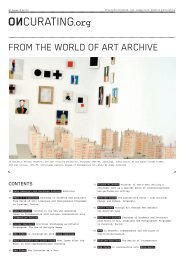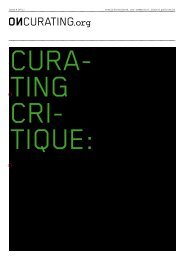Create successful ePaper yourself
Turn your PDF publications into a flip-book with our unique Google optimized e-Paper software.
022 Issue # 11/11 : PublIc Issues<br />
Xitong's decree in 1983, all buildings in Beijing started<br />
to receive a green, antique-looking roof, which can be<br />
considered <strong>as</strong> a highlight of modern architecture history.<br />
This action, <strong>as</strong> well <strong>as</strong> the demolition of Beijing's city<br />
wall after the founding of the Republic, served to fulfill<br />
political needs.<br />
The end of 1980s and the beginning of 1990s were character-<br />
ized by an atmosphere of repression. Most people chose<br />
silence <strong>as</strong> a counterme<strong>as</strong>ure. In the 1990s, the Chinese<br />
economy w<strong>as</strong> affected by the Asian financial crisis and<br />
came to a standstill. This caused a short period of distress<br />
for economy-driven, futuristic cities that had been built<br />
from the ground, like Shenzhen or Shanghai's Pudong dis-<br />
trict. The 1990s were also the beginning of the government's<br />
emph<strong>as</strong>is on the cultural industry, and they marked the<br />
start of city beautification campaigns. Many monuments were<br />
created and all of them had wonderful motifs. But no other<br />
city than Guangzhou found a sculpture that better repre-<br />
sented its city culture than the stone sculpture of the Five<br />
Goats. 12 Yet the m<strong>as</strong>ses of old leader statues were still<br />
occupying too much public space; until today, flower beds<br />
and roundabouts in folkloristic styles still dominate<br />
public space.<br />
Since the year 2000, the cosmopolitan cities of Beijing<br />
and Shanghai have been hosting m<strong>as</strong>sive actions to improve<br />
their image. On 13th July 2001, Beijing w<strong>as</strong> awarded the<br />
Olympic Games, and started a worldwide design competition<br />
for the Olympic stadiums. After the Games, they all have<br />
become important landmark buildings and public culture<br />
venues. The Shanghai Expo 2010 used Beijing's experience<br />
to make the most of its own event. All the buildings were<br />
temporary, only the China pavilion w<strong>as</strong> kept. Furthermore,<br />
the CCTV Headquarter, designed by Rem Koolha<strong>as</strong>, and the<br />
Shanghai Tower came into being. These colossal and unique<br />
architecture projects were already designed <strong>as</strong> landmarks<br />
and media centers. While they are still connected to<br />
politics, they are also inseparable from business and<br />
culture.<br />
Epilogue<br />
This essay h<strong>as</strong> attempted to depict the changes in China's<br />
public and public culture in the p<strong>as</strong>t 100 years. I hope<br />
to have provided the reader with a rough idea, despite the<br />
limited space available. Public = people's need = standard-<br />
ization of political culture = media can be seen <strong>as</strong> a<br />
summary of the meaning of the term public in China from<br />
1949 to 1978; this is a one-way, vertical process, which<br />
responds to popular desires and party expectations. After<br />
1978, whether political or popular needs, many more fac-<br />
tors came into play. Public art is a vertical need of the<br />
government, a political need to reconstruct cities. As<br />
soon <strong>as</strong> the media and information distribution by the<br />
people came to life, the public's legitimacy and totality<br />
faced questioning and rejection. This led to the emergence<br />
of an even bigger information network, which then turned<br />
into an online public sphere. This phenomenon took an<br />
immediate effect on the formation of the public and of<br />
public art. Today, the public can be created for three<br />
different re<strong>as</strong>ons: 1. political needs; 2. personal benefit;<br />
3. media event. Coincidentally, these <strong>as</strong>pects are also<br />
shaping today's contemporary art.<br />
Both domestic and international transitions have led to an<br />
overall variation and diversification of public awareness<br />
in the course of the globalization process, and are slowly<br />
helping to overcome national borders and boundaries. By<br />
way of comparisons, conversions and exchange, more public<br />
issues will be raised, like the environment question,<br />
12<br />
Designed by<br />
famous sculptor<br />
Yin Jichang and<br />
others in 1959 to<br />
perpetuate the<br />
goat <strong>as</strong> Guangzhou's<br />
city<br />
symbol, this is<br />
an artwork full<br />
of poetic grace.<br />
13<br />
See:<br />
http://sharism.org<br />
youth education, unemployment, the emergence of migrant<br />
workers, the dangers of coal mines, and many more.<br />
There is also the concept of concealment, which h<strong>as</strong> always<br />
existed within tradition and culture. This h<strong>as</strong> not ce<strong>as</strong>ed<br />
existing despite revolutions and reforms, but h<strong>as</strong> become<br />
an integral part of China's cultural heritage and the back-<br />
bone of the elite and intellectuals. Its traces can be found<br />
today in the structures of ancient buildings, gardens, and<br />
paintings.<br />
Returning to the issue of ideology issue, if China's poli-<br />
tics and public both belong to this domain, then it also<br />
concerns modern and contemporary art. Chinese artists have<br />
always had a pragmatic attitude towards this issue, <strong>as</strong> the<br />
famous final line in the film version of the novel The<br />
Miraculous Pigtail nicely illustrates: 'The pigtail is gone,<br />
but the spirit is still here' (Feng 1984). This clearly<br />
shows a non-compromising inner nature, while being able to<br />
adapt to reform and revolution. Here, we need to discuss<br />
the re-thinking of culture, a question already to be found<br />
in the writings of Joseph Needham (1900 — 1995):<br />
"First, why did modern science only develop in<br />
Europe, but not in Chinese (or Indian)<br />
civilizations?<br />
Second, why w<strong>as</strong> the Chinese civilization between<br />
100 B.C until 1500 A.D. so much more effective<br />
than Europe in applying mankind's natural know-<br />
ledge to its practical needs?"<br />
So what does China's current public environment and spirit<br />
look like? Everything that I have mentioned above needs to<br />
be considered to answer this question. Since we are living<br />
in a multifaceted era with many networks, all the events<br />
that took place before have a subtle butterfly effect on<br />
our world today. Never before h<strong>as</strong> anything superseded<br />
the rules of a society within an existing ideology in such<br />
a short time. Ideological transition is the first step<br />
towards universal change. Those ideologies that are gradual-<br />
ly dying away will cause a shift within the external world,<br />
from its buildings to its aesthetics.<br />
After the creation of sharism, the ideology of sharing con-<br />
structed by the public, what will a world look like where<br />
information is completely disclosed? 13 Will China, after<br />
its official entry into the WTO, be affected by the next<br />
financial crisis? Also, have the problems and morality<br />
constraints that arise from sharing led to the construction<br />
of self-imposed limits? How should we consider matters in<br />
such a complicated situation? Of course, these issues are<br />
already part of the ideology of contemporary art. What,<br />
we may <strong>as</strong>k, is not public today? Knowledge is like a speed-<br />
boat: I am in the boat, looking at the sea, sometimes<br />
looking up at the stars.<br />
What might be more important than all of this is perhaps<br />
simply forgetting to explain the concepts of public,<br />
contemporary, politics, sharing, and so on, or at le<strong>as</strong>t<br />
to stop using these memorized, simple words with some


![Download as PDF [10.6 MB]](https://img.yumpu.com/4266533/22/500x640/download-as-pdf-106-mb.jpg)

